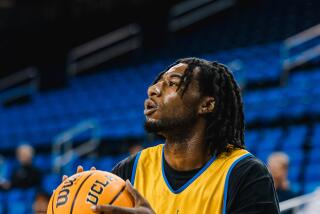Thanks, Bruins
- Share via
College basketball was different back then, before wall-to-wall television coverage and the Internet, before everyone started filling out their brackets and handing over five bucks for the office pool.
Through the 1940s and ‘50s, the NCAA tournament wasn’t so much the Big Dance as a block party, barely two dozen teams invited to play. Barely anyone noticed. Call it March Mildness.
Then came UCLA.
The Bruins reeled off seven consecutive championships starting in 1967, a feat that caught the nation’s eye and still ranks among the greatest runs in American sports history.
In the midst of it all, some worried about the effect on the game. Surely fans would tire of the same team winning every year with that bespectacled John Wooden on the sideline, clutching a rolled-up program.
Forty years later, hindsight provides a different perspective.
By the time the Bruins were finished, the NCAA tournament had expanded its field and was poised to become one of the premier events on the sports scene. Soon, sponsors came calling and television signed up for live broadcasts from the first-round tipoff to the final buzzer of the championship game.
Pete Newell, the legendary coach, said the spectacle of UCLA’s dominance “gave us a big, big push.” Others agree.
“College basketball needed the New York Yankees. It needed the Boston Celtics,” said Jim Haney, who coached against the Bruins at Oregon and now heads the National Assn. of Basketball Coaches.
“It needed someone -- who turned out to be Coach Wooden and UCLA -- to say something special is happening in this sport.”
*
The Bruins actually began winning in 1964 and ‘65, capturing their first two titles. They fell short the next season, but it was a momentary pause.
The 1966 NCAA tournament was called the “last chance” championship, because fans had seen Lew Alcindor -- now Kareem Abdul-Jabbar -- play his mandatory season on the UCLA freshman squad and knew that once he joined the varsity, the Bruins would be unstoppable.
The next seven years brought a handful of upset losses but mostly blowout victories. In 1967 and ‘68, the Bruins won by an average of more than 25 points. In 1972, with UCLA led by Bill Walton, the margin of victory was an NCAA-record 30.3 points.
Lynn Shackelford, a UCLA forward in the late ‘60s, recalls newspaper and magazine articles wondering whether his team’s success might ultimately harm college basketball.
Yet everywhere the Bruins played, rival fans packed the arenas.
“It felt like we were a traveling circus,” Shackelford said. “They rolled out the red carpet and we put on our little show.”
Their seven-year run included “The Game of the Century” against Houston in 1968, which drew more than 50,000 to the Astrodome and one of college basketball’s earliest national television audiences. A few years later, an 88-game winning streak attracted media coverage unprecedented for the game.
Several factors fueled this celebrity. The process began, of course, with victories.
Neal Pilson, former head of CBS Sports, equates UCLA with other dynasties such as the Yankees, Celtics and the NFL’s Green Bay Packers.
“The public is drawn to teams of championship caliber,” Pilson said. “They’re generally good television.”
Appropriate for a team that played a few miles down Sunset Boulevard from Hollywood, UCLA also benefited from an all-star cast.
Start with Wooden, a quietly stern man whose persona bespoke equal parts coach and country schoolteacher. Years later, reports would link his program to booster Sam Gilbert and improper benefits to players, but in the early days Wooden’s image approached sainthood.
Then came his players. After Alcindor graduated, the team reloaded with two new stars, forwards Curtis Rowe and Sidney Wicks. They were followed by yet another dominant big man in Walton.
“It wasn’t just that they were winning, they were winning with big names,” said Tom Odjakjian, a former ESPN executive and now associate commissioner of the Big East Conference. “It’s like when Tiger Woods is up by 10 strokes on the final day of a golf tournament -- people still tune in to watch.”
If all those victories and marquee names weren’t enough, the Bruins commanded attention yet another way.
Good old-fashioned contempt.
Television executives Pilson and Odjakjian said they never underestimated the viewership that tuned in simply hoping to see a team lose. Bruins players sensed it too.
“People loved to hate us,” said Larry Farmer, a forward in the early ‘70s who later coached the team. “When you ran onto the court, it was either going to be a sea of cheers or a chorus of boos.”
*
Through the 1950s and into the ‘60s, college basketball cognoscente suspected their game -- often overlooked by television and the national media -- could grow.
“You knew, just looking at college football, that there was potential,” Haney said. “But how would that potential ever be reached? A lot of things had to come together.”
The tournament served as catalyst.
Starting in 1975, as UCLA won its 10th championship in 12 years, the NCAA threw out a long-standing rule that limited each conference to one team in the postseason. This allowed for classic tournament matchups such as Duke-North Carolina and Michigan-Indiana. A few years later, officials began seeding and balancing the brackets, moving teams around the country, which made for better early games.
Finally, in 1980, came a match made in heaven. A young ESPN, looking to make a splash, signed up to televise the early rounds. March Madness was born.
Looking back, people in and around the college game say this boom was probably inevitable yet -- just as probably -- accelerated by UCLA’s historic run.
“Certain teams can make a difference,” Pilson said. “The rise and dominance of UCLA and Coach Wooden ... I think it made a very significant contribution to the growth of the sport.”
All these years later, Farmer looks at the state of the game -- so much television, so much fan interest -- and can’t help feeling that he and his teammates played a role.
Even back then, they sensed something historic afoot.
“Love us or hate us,” Farmer said, “you followed us.”
More to Read
Go beyond the scoreboard
Get the latest on L.A.'s teams in the daily Sports Report newsletter.
You may occasionally receive promotional content from the Los Angeles Times.







